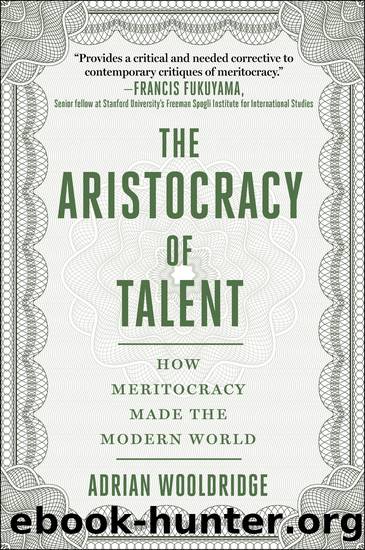The Aristocracy of Talent: How Meritocracy Made the Modern World by Adrian Wooldridge

Author:Adrian Wooldridge [Wooldridge, Adrian]
Language: eng
Format: epub
Tags: political science, Political Economy, Labor & Industrial Relations, Public Policy, Economic Policy
ISBN: 9781510768628
Google: uOU3EAAAQBAJ
Publisher: Simon and Schuster
Published: 2021-07-13T23:47:26.307815+00:00
PEOPLE OF PLENTY
Post-war America saw many of the same developments as post-war Britain: the growing conviction that, in Churchillâs phrase, âthe empires of the future will be empires of the mindâ; the commitment to an expanded welfare state, albeit a welfare state with American characteristics; and, above all, the quest for a fairer post-war order. The same themes were nevertheless woven together in rather different patterns. America had the benefit of more variety than Britain: meritocratic educational initiatives were sponsored by companies and think tanks as well as governments, meritocratic government reforms were spear-headed by think tanks, particularly the Rand Corporation, as well as government departments. America did not suffer from the same agonies of class guilt as Britain (though it suffered from worse agonies of racial guilt, agonies that were suppressed during the 1950s but transformed politics in the 1960s). In post-war America the meritocratic revolution was all about delivering the promise of American life, as codified in the Declaration of Independence and the constitution, rather than overturning an unjust social order.
The great harbinger of the meritocratic revolution was the GI Bill. More than 1.6 million veterans enrolled in college in 1947 alone, a number equivalent to the total college population in 1940, and more than 60 per cent of them studied science and engineering. Post-war America was much more inclined to romanticize the scientific hot-houses such as Berkeleyâs Lawrence Livermore Laboratory that had produced the nuclear scientists who had done so much to win the war than it was to look back at F. Scottâs Fitzgeraldâs Princeton.
Some Americans also began to reject the racial prejudices that had been so open in pre-war America. Harry Truman took a much tougher line on civil rights than his predecessor: the Presidentâs Commission on Civil Rights published the landmark âTo Secure These Rightsâ (1947), which argued that the federal government had a duty to secure rights as well as just to prevent abuses, while the Commission on Higher Education published the equally forthright âHigher Education for American Democracyâ (1947), which described quotas directed against Jews and Negroes as âun-Americanâ, while Gentlemanâs Agreement (1947), a film starring Gregory Peck, won an Oscar for its devastating portrayal of gentlemanly antisemitism. Carey McWilliamsâs Mask for Privilege (1948) detailed just how widespread the prejudice remained. By 1952, public opinion polls began to show a marked decline in antisemitism.20
America embraced IQ tests and their various offspring, such as SAT tests, with an even greater enthusiasm than the British, though they preferred to use them to stream children rather than to separate them out into sheep and goats at eleven. The Truman Commission rested its case for expanding college enrolments on the results of the Army General Classification Test (AGCT), which had been administered to 10 million recruits during the Second World War and which revealed a lake of untapped ability in the population at large: 49 per cent of the population had the brains to complete fourteen years of schooling and 32 per cent had the brains to complete college.
Download
This site does not store any files on its server. We only index and link to content provided by other sites. Please contact the content providers to delete copyright contents if any and email us, we'll remove relevant links or contents immediately.
Machine Learning at Scale with H2O by Gregory Keys | David Whiting(4260)
Never by Ken Follett(3884)
Harry Potter and the Goblet Of Fire by J.K. Rowling(3808)
Unfinished: A Memoir by Priyanka Chopra Jonas(3356)
Fairy Tale by Stephen King(3307)
The Man Who Died Twice by Richard Osman(3040)
Will by Will Smith(2873)
Rationality by Steven Pinker(2327)
The Dark Hours by Michael Connelly(2280)
Can't Hurt Me: Master Your Mind and Defy the Odds - Clean Edition by David Goggins(2277)
It Starts With Us (It Ends with Us #2) by Colleen Hoover(2256)
The Storyteller by Dave Grohl(2198)
Friends, Lovers, and the Big Terrible Thing by Matthew Perry(2182)
The Dawn of Everything: A New History of Humanity by David Graeber & David Wengrow(2159)
The Becoming by Nora Roberts(2153)
The Stranger in the Lifeboat by Mitch Albom(2093)
Cloud Cuckoo Land by Anthony Doerr(2061)
Love on the Brain by Ali Hazelwood(2025)
Einstein: His Life and Universe by Walter Isaacson(1985)
